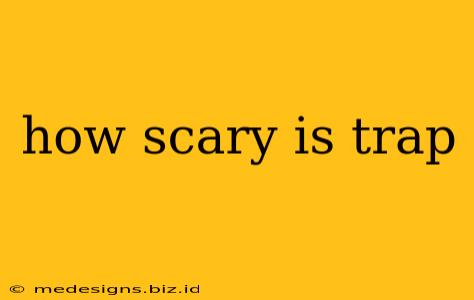Trap music. The name itself evokes images of danger, lurking shadows, and potential peril. But how accurate is this perception? Is trap music inherently scary, or is it simply a genre that utilizes certain sonic elements to create a specific atmosphere? Let's delve into the heart of this question.
The Sounds of Fear: Analyzing Trap's Darker Elements
Trap music's reputation for being "scary" isn't entirely unfounded. Several key elements contribute to its often unsettling vibe:
1. The 808 Bass: The deep, booming 808 bass drum is a staple of trap. Its low frequency resonates physically, creating a visceral feeling that can be both exhilarating and unsettling, depending on the context. This powerful, almost overwhelming sound contributes significantly to the genre's intense atmosphere.
2. Dark and Ominous Melodies: Many trap tracks utilize melancholic or minor key melodies. These melodies, often synthesized, can create a sense of unease and foreboding, amplifying the overall dark tone. Think of the creeping synths and haunting melodies that characterize many popular trap songs.
3. Distorted Sounds and Vocal Effects: The use of heavy distortion on vocals and instruments further enhances the unsettling nature of trap. This creates a sense of rawness and aggression, adding to the feeling of chaos and danger. The effect can feel menacing and amplify the overall intensity.
4. Thematic Content: Lyrics often explore themes of violence, drugs, and criminal activity. This lyrical content, combined with the aforementioned sonic elements, can certainly make certain trap songs feel unsettling or even frightening to some listeners. It's the combination of sound and message that creates a powerful effect.
Subjectivity of Fear: What Scares One Person Might Not Scare Another
It's crucial to remember that the perception of "scariness" is subjective. What one person finds unsettling, another might find exciting or simply intense. The impact of trap music's darker elements will vary greatly depending on individual sensitivities, cultural background, and personal experiences.
Beyond the Darkness: Exploring Trap's Diversity
While the darker elements of trap are undeniable, it's important not to paint the entire genre with the same brush. Trap music encompasses a vast spectrum of sounds and styles, ranging from dark and aggressive to upbeat and celebratory. Many trap tracks utilize the genre's signature sounds in a way that’s energetic and exhilarating rather than frightening.
Conclusion: A Spectrum of Sound and Emotion
Ultimately, how "scary" trap music is depends entirely on the listener's perspective and the specific track in question. While certain elements contribute to its often intense and unsettling atmosphere, it's a genre rich in diversity and expression. It's a genre that uses sound to evoke powerful emotions, and those emotions can range from fear to excitement to everything in between. So, next time you listen to trap, consider the multifaceted nature of the genre and how it affects you personally.
